Growing
up in Herstmonceux
I
moved to Herstmonceux, a small village in East Sussex
between Bexhill and Hailsham in 1928 when I was five
years old. I
lived in ‘North Lodge’, the little gatehouse cottage
on the Lime Park Estate at the Gardner Street/Hailsham
Road end of the long drive to the big house.
My father, William (Ernie) Green had gone to
London when he left school to do an engineering
apprenticeship at the Clement Talbot Car Factory.
It was there he met my mother, Doris, (actually
Millicent Doris) who lived in Wembley and was a
tailoress, trained by a Jewish gentleman in the City of
London. Because
of the industrial unrest of the 1920’s they returned
to Sussex to get married, and lived with his parents at
Hodges Farm in Bodle Street. (This was where I was born)
He
did various labouring jobs before becoming chauffeur to
Mr William Matthey, a diamond merchant, who lived at
Bucksteep Manor. When
Mr Matthey died, Captain Gardiner, whose wife Mum had
met through the Women’s Institute, gave my father a
reference for the position of chauffeur to Mrs de Roemer
of Lime Park. He
was accepted for the position and this was his job for
the next twenty years or more.
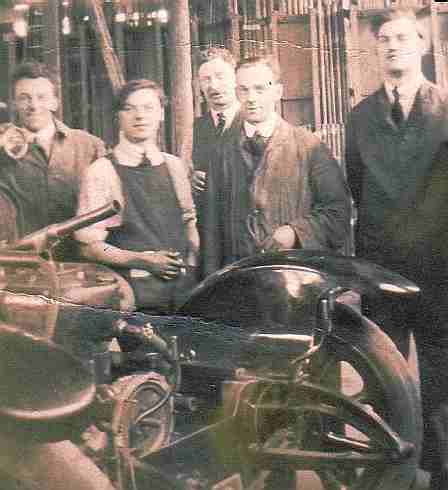
William
Green at the Clement Talbot factory, London
Dad
drove the large Armstrong Siddeley car, registration BXP
153, which was garaged in the old stable block near to
the house. It
was quite luxurious with silky tassels on the blinds
over the rear windows and wide running boards.
His duties were to take Mrs de Roemer to visit
friends at some of the large country houses around the
locality, also shopping in Bexhill or Eastbourne. He
always looked smart in his chauffeurs uniform and cap.
When Miss Benita, Mrs de Roemer’s
granddaughter, came to stay he would drive her to the
Opera at Glyndebourne, and to parties with friends.
One wet evening he had to carry her over the
puddles, to prevent her spoiling her gown.
He also had to drive Mrs de Roemer to London
every year where she stayed for two weeks at the Carlton
Club with her lady friends.
When she was away Mum and Dad stayed at the
house. On one occasion Mum was waiting in the hall of
Lime Park to see the lights of the car coming down the
drive. Something
landed on her head.
When Dad got in after parking the car he had to
extricate a small bat that had attached itself to her
head!
At
that time the de Roemer household had its full
complement of staff, with a butler, Mr Marshall; a head
housemaid, Miss Hicks who was always dressed in a long
black dress and white frilly cap; a cook, Mrs Philips;
Myrtle the scullery maid etc.
There was a large walled garden that was looked
after by the head gardener, Mr Stapeley, and the
under-gardeners, Ron Simmons, Billy Medhurst, Albert
Ransom and others. The garden provided fresh produce and
flowers for the house.
Mum
also worked at the house, mainly helping in the kitchen,
especially preparing meals for guests who visited, such
as Lady Gage from Firle Place, Lady Shawcross, or Lady
Hailsham, Lord Hailsham’s first wife. Quite often they
would come in the kitchen and shake hands with the
staff. Mum
herself was quite refined, and always claimed that her
mother, Melinda Caroline Ross, was the daughter of a
Lord Ross who had a castle somewhere in Scotland, but
she was cut off from the family when she eloped with her
working class husband, John Preston Oates.
Whether this is true or just a bit of family
folklore, we have never been able to establish, but she
did have me christened Margaret Joyce Ross Green.
They went on to have ten children, five boys and
five girls, and my uncles and aunts and cousins used to
come and stay with us at the cottage.
My
dad’s mum was Annie Springett, a descendent of the
Springett family who owned a large Elizabethan manor
house, Broyle Place, near Ringmer.
Her ancestor was Herbert Springett, the twin
brother of Sir William Springett who died of his wounds
at Arundel Castle in 1643 while fighting for the
Parliamentarians in the Civil War.
His pregnant wife reached his bedside just before
he died. When
the little girl was born she was called Gulielma Maria
Posthumous Springett and grew up to marry William Penn.
Sadly, she and all her children died.
He then remarried and went off to the Americas
and founded Pennsylvania.
Some American cousins, Grace and Eldon Springett,
the children of Annie’s brother Rowland, who emigrated
from England to California in 1889, researched all this.
Major
de Roemer had died during the 1914-18 war (I am not sure
of the date, or where he is buried).
He had come from Germany in the 19th
Century as Baron von Roemes.
They had one son, Charlie, who lived in Wimbledon
with his wife Audrey (who my mother liked very much) and
their four children, Benita, Martin, Anthony and Boyce.
The boys all went to Somerfields School, a private
boarding school in Bohemia, Hastings.
When the children came to visit their grandmother
I played with them, especially Martin, as we were about
the same age and both loved collecting butterflies.
He would come up the drive to the cottage gate to
show me his latest acquisitions.
The
little cottage was very picturesque with clipped box
hedges all around and pretty latticed windows.
It was small and cosy with a range in the
kitchen, and a big copper for the washing.
The water was pumped straight from a well in the
garden and was lovely and fresh.
At the bottom of the garden was the ‘privvy’.
In the distance we could just see the South Downs
beyond Eastbourne.
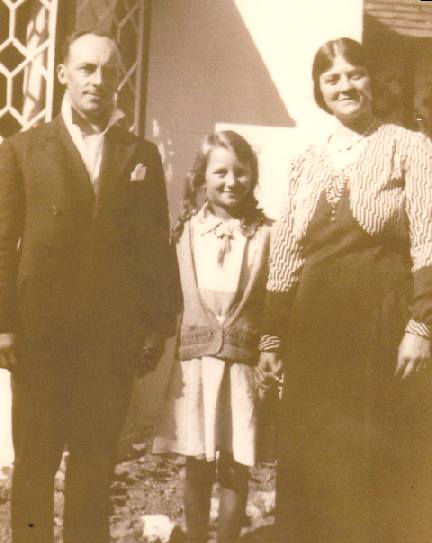
William,
Peggy and Doris Green
Life
was very happy for a little girl. I went to the local school in the village.
Mr Bridgen was the headmaster and he lived up
West End. He
had two daughters, Rita who I went to school with, and
Monica, and one son (who was lost at sea in the war).
I belonged to the Brownies, which was run by
Verily Bruce, the vicar’s daughter. I attended the
little tin church (long since demolished) up the path to
the recreation ground with my friend Barbara Snatt whose
dad was a butcher.
Later on I was confirmed in Wartling Church, and
then went once a month to the early morning service at
All Saints Church. Mum and Dad took me on bike rides, going swimming at the
beach at Pevensey Bay, and even cycling as far as
Brighton, where I once got my wheels stuck in the
tram-tracks, much to my Dad’s frustration!
We used to cycle to Arlington to watch Speedway -
I loved that!
Evenings
were spent in simple entertainment.
Card games were favourite, and we often cycled
over to Bodle Street to play with my grandparents at the
farm. It
was wonderful cycling home along the lanes in the small
hours of the morning hearing the nightingales singing
and seeing the glow-worms in the banks and the stars
shining overhead.
My
mum continued in the WI and used to win prizes for her
home-made jams and preserves.
She continued to use her tailoring skills in
making dresses and coats, thus keeping us up with the
fashion without spending a fortune. Dad grew vegetables in the garden as well as raspberries and
sweet peas.
When
I got older I went to the secondary school in Hailsham,
where I enjoyed playing netball.
We also liked playing tennis, and had some
wonderful times on the tennis courts that Charlie de
Roemer laid out, and which are still there on the
recreation field today.
(Charlie was known for first introducing
electricity to the village, which was produced on the
estate and supplied by cable to several of the houses. He was quite a benefactor to the village).
I really adored playing tennis. Mr Davis Gilbert
allowed us to play on the hard court at his house up
West End. The tennis club had a thriving membership
including Mr Percy Phipps, the local chemist, and many
others. I was never short of partners!
When
I was fifteen my dad thought I should learn to drive,
and decided I could have a ‘go’ in the Armstrong
Siddeley! He
was scheduled to pick up Mrs de Roemer from Polegate
station that afternoon and had to take the car up to the
cottage from the stables.
He let me drive it and all went well as we
proceeded up the long drive. The bend at the top proved a little more difficult and I
unfortunately hit the accelerator instead of the brake!
My dear mother, who was waiting for us outside
the cottage, had the presence of mind to leap out of the
way as we careered into the fence!
Well, a quick dash to Herbie Harris’s garage, a
borrowed limousine, a mysterious mechanical fault and a
vow to secrecy got dad out of a dreadful fix!
It was over thirty-five years before I had
another go at driving.
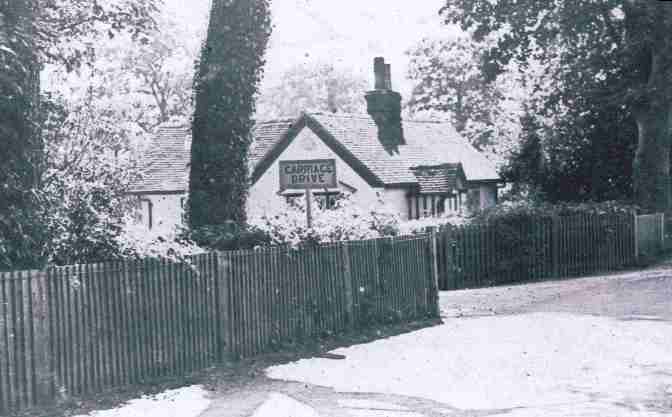
North
Lodge, Gardner Street, Herstmonceux
Work
and The War
I
left school at fourteen and went to work in one of the
village grocery shops, run by Jack and Ethel Snatt.
The village, as now, had a busy centre with
plenty of shops and small businesses. One of the most notable was the Trug factory run by the Smith
family in the big barn nearly opposite the cinema. Mrs Angears, from the Woolpack, made homemade chocolates and
her two sons, Roy and Jeff, followed in her footsteps
with a very successful boiled sweet business, which
carried on for many years. Mr Honeysett was the baker, and the butchers was run by
another Mr Snatt, Cecil.
Mr Seymour had a gift shop, and the Ponts had a
grocers and drapers.
Johnny and Pat Allcorn lived near the junction
with West End. Pat
ran a cycle business and was always in his boiler suit.
Johnny was always smartly turned out in a city
suit and bowler hat. Old Mr Wissam had his boot repair workshop opposite the shop
where I worked. Up
West End Mr Crouch distributed the daily papers from his
home. The post office was run by Mr and Mrs Beal, and
Mrs Beal was an extremely efficient postmistress.
Next
to the gift shop was a lovely house with a spreading
cotoneaster across the front that had been trained into
the words ‘Praise the Lord’.
Two elderly ladies who were sisters lived in the
house, and I believe they were Methodists. It was quite
a famous landmark and coach parties would be driven out
from Hastings on summer evenings to see it, on their
tours of the Sussex countryside.
There
was another butchers shop further along the road owned
by Edgar Curtis. He was quite a character, and I think he had helped to build
the cinema in the village.
Mr Curtis also kept a herd of cattle in the field
opposite our cottage before the houses were there.
One summer’s evening we were leaning on the
fence outside the cottage watching him get the cows in.
The last one was being a bit obstinate.
“Get up there, S** ya!” he yelled as he walloped her with his stick.
“Sonya? That’s
a funny name for a cow,” said Mum!
I
was nearly sixteen when war broke out.
Soldiers were billeted at Herstmonceux Place, and
they were allowed to come up to the village hall in the
evenings for refreshments and entertainment.
The ladies of the village would serve them with
tea and biscuits. I
was expected to help them with this, but I was having much more fun
playing table tennis with the lads!
On
one occasion I was at my grandparents’ farm in Bodle
Street with my cousin, Jeff Green.
We got a bit bored and decided to go off on our
bikes. We ended up back at North Lodge where Jeff suggested I play a
few tunes on the piano.
(I had learned to play when I was younger,
reaching Grade V, so I wasn’t too bad).
We returned to the farm later on, where we stayed
the night. The
next day when we all went back to the cottage my dad had
a visit from Mr Boon, the Air-Raid Warden.
Jeff and I had carelessly left a light on in the
sitting room. This
was a very serious offence and Mr Boon said it would
have to go to court.
My dad duly had to attend the magistrate’s
court in Hailsham a few weeks later and was fined the
sum of ten shillings.
He was not very pleased with me for a few days
after that!
One
day we heard that there had been an air raid at
Crowborough. I
jumped in the van with Jack Snatt and we rushed off to
see the damage. A plane had been shot down and we
arrived just as they were burying two German airmen in a
makeshift grave. On another occasion the air raid siren
went off while the Stewarts traveller, Mr Fisher, was in
the shop. We
all dived down behind the counter and waited for the
danger to pass. “I don’t think you’ll be needing to order any All Bran
this week, my dear,” said the salesman!
I
enjoyed my work at the shop. I used to take the nets off
the big round cheeses, help slice up the bacon, as well
as place orders with the travelling salesmen who called,
such as the Hollands Flour rep.
We also served paraffin from a little shed out
the back near the builder’s yard.
Jack used to go off in the van in the morning and
bring back orders from his various customers.
While he was having his lunch, I would start to
make up the orders and pack them into the large wooden
crates that the eggs were supplied to us in.
Then he went back out in the afternoon to
deliver. Sometimes
we had to order things in specially, like a ‘bladder
of lard’ for Lord and Lady Hailsham who lived at
Cowbeech. Their
housekeeper, a rotund little lady in a black dress,
would come in from time to time to order this.
One of our customers, Mrs Johnson, would ring up
early in the morning and order some bacon, cut on number
3 (very thin), and I would go down to Flowers Green on
my bike to deliver it to Edith the cook to fry for Mrs
Johnson’s breakfast.
It
was at the shop that I met my husband, Bill.
He came every week in his lorry from Stewarts,
the wholesale grocers in St Leonards, to deliver stock.
He would come whistling along with the parcels,
or a side of bacon on his shoulder and take them to the
storeroom off the little passage opposite the shop.
It wasn’t long before romance blossomed and we
were engaged!
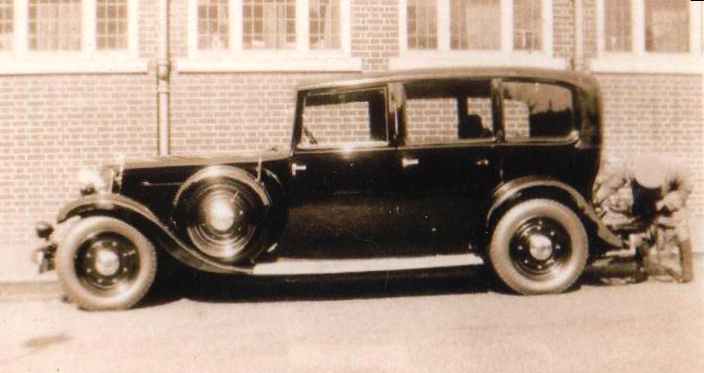
William
Green and the Armstrong Siddeley limousine
My
Wedding and the Years Following
We
got married on the 28th November 1942, when I
was 19. It
was wartime, so there were no big white weddings, but it
was a very happy day, none the less.
Bill had to get off the bus on the main road and
walk down the long lane to the church.
I think his best man got him some dutch courage
along the way in the Kicking Donkey (run by a jolly
cockney couple Cissy and Stan Sinden)!
The Revd Rosslyn Bruce married us.
He was quite well known for his sermons, but also
for rather more eccentric behaviour – did he really
try to breed green mice? The vicarage was on Buckwell
Hill where he lived with his wife, three daughters, and
one son who he sadly lost in the war. We sang ‘Praise my soul the King of Heaven’ and ‘Love
Divine all Loves Excelling’ then all proceeded back to
the cottage for the reception.
What
a lovely meal we had!
Mr Honeysett had baked the rolls for us, Mr Snatt
provided the cold meats – ham and tongue – and The
Huntley and Palmers rep that I had talked to in the shop
had a wedding cake made especially. He said they wouldn’t be able to do white sugar icing, but
it would be covered in white card and decorated to look
like the real thing.
How we got round the wartime rationing!
The ladies who I served in the shop had given me
their clothing coupons so I was able to have a wedding
dress and matching bolero jacket, and a pretty hat, plus
a ‘going-away outfit’ as well.
Mrs de Roemer and her friend, Mrs Cook, walked up
from the big house and had a celebratory drink with us.
It was a wonderful day!
Our
first home was in a flat in Bexhill Road, St Leonards
and I continued to travel back by bus to work in the
shop until I gave up to have my son, Donald. By that
time we had moved to Bexleigh Avenue where our two
daughters, Doreen and Heather were also born. We
sometimes went back to Herstmonceux to stay with Mum and
Dad, and one day, before the children were born, we were
waiting on the main road for the bus to Hailsham.
A beautiful Rolls Royce drew up and the driver, a
tall, fair-haired gentleman, enquired where we were
going. When
we told him he said “Jump in, I’ll give you a
lift”. When
we reached Hailsham, Bill whispered to me “Shall I
give him a tip?” “Don’t do that” I whispered
back. “That’s Sir Paul Latham, he owns Herstmonceux
Castle!”
We
used to enjoy taking our first two children back to the
cottage. Dad
would take his little grandson fishing in the small lake
near East Lodge, and we would pick up the huge fir cones
on the lawn underneath the big fir tree, just as I had
done as a child. We
were invited to the wedding of Monica Isted.
She was the daughter of Emmie and Frisby Isted,
Mum and Dad’s friends, and also Doreen’s godparents.
Doreen was a bridesmaid and Don a pageboy.
The reception was held at the Monkey Puzzle.
I
also used to go back occasionally and visit Jack and
Ethel in their house next to the shop.
They had two daughters, Doreen and Gillian.
Ethel’s sister, Evie, was married to Herbie
Harris who had the garage at Boreham Street with his
brother Albert. When
they retired Jack and Ethel moved to a lovely new house
at the top of the hill, and I visited them there as
well. They
had a person who did gardening work for them, Fred
Honeysett, and I remembered him and his sister, Audrey,
from my schooldays.
The
End of an Era
In
1951 Mrs de Roemer died, (the same year as my Granny
from Bodle Street).
By that time nearly all the other servants had
died or left, and nurses were brought in to look after
her. My
mother was with her to the end, preparing her simple
meals as her health deteriorated.
Everything was put up for sale and Lime Park
House was divided up in to four separate dwellings. Charlie dearly wanted Mum and Dad to move up to Wimbledon to
be their chauffeur and house-keeper but, with the four
grown-up children, Dad could envisage a lot of late
nights driving them to parties etc. and anyway, they
didn’t want to move far away from their own family.
They moved out of the little cottage and after a brief
spell with us, moved into a lovely new council flat in
Archery Walk in Hailsham.
We often wondered what happened to the Armstrong
Siddeley. Did
it end up at a funeral directors in Eastbourne?
Mr and Mrs Stapeley stayed on in East Lodge for
many years. He
was quite reserved, and she was very tiny and timid. I remember Mr Stapely giving me a thre’penny piece every
Christmas. Their
only daughter, Kate, died of a brain tumour just six
weeks after she got married to Gilbert Walters from the
village, which was very sad.
John Walters, Gilbert’s brother, worked for J W
Barnes, agricultural engineers at Bodle Street.
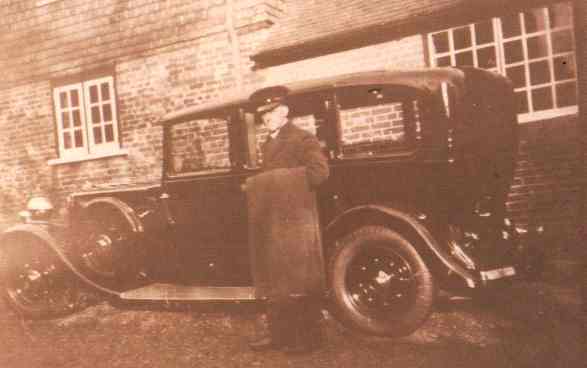
Armstrong
Siddeley parked outside the stables - now The Old
Rectory, Lime Park
Dad
got a job at Bourne and Burgess’s garage on the main
street in Hailsham, where he worked on the petrol pumps
and forecourt until he died.
(He had known the two partners since his younger
days). He
actually died at the garage of a very sudden heart
attack when he was just 65.
Mum had gone to work for Colonel and Mrs Johnson
who moved to Merley Hall on Kings Drive in Eastbourne.
They had lived at Flowers Green, and Mrs de
Roemer had let her exercise her red-setter dogs across
Lime Park. Their
son, Colin, who was the same age as me, but went to
Radley College for his education, was tragically killed
in an accident on his racing bike while following his
father’s army vehicle through the village.
Visitors
to Merley Hall included Colonel Bowser who had a very
early 1913, bright yellow, vintage Bullnose Morris car,
and Captain and Mrs Vorsboys from Folkington Manor.
One of their sons, Rufus would sometimes give Mum
a lift back to Hailsham in his car, which saved her the
long walk up Hampden Park Road to the bus stop. Mum
continued to work there until she was eighty, when Mrs
Johnson died. She
spent her last four years with us and died in 1983, just
before her eighty-fourth birthday.
My
cousin Jeff had plaques made several years later, for my
Mum and Dad, and also his parents, and they are on the
graves of my grandparents who are buried in the
churchyard of Herstmonceux church.
The
Later Years
I
continued to exchange Christmas cards and brief items of
family news with Martin de Roemer for many years. His
grandmother had left him the bulk of her money and he
had been a Lloyds Underwriter, but his fortunes had
suffered with those of that famous company. He had remained a bachelor.
Around the year 2000 I stopped hearing from him
and a little while later I had a letter from Benita, who
told me that, sadly, Martin had died of bone cancer. As
she was by then on her own, he had moved in with her
when he became ill and after he died she had found my
address among his papers.
Benita said she still
remembered me, sailing down the drive at Lime
Park on the handlebars of Dad’s bike - my ringlets,
which Mum had tied up with rags the night before,
blowing in the wind.
Of
the other children I have no information, except that
one of the boys, probably Boyce, died at an early age
and Anthony also stayed single.
Benita married Mr Oliver Moxon, they didn’t
have any family, and she later remarried after
Oliver’s death. (My
son-in-law found a reference on the Internet to a
restaurant called Moxons in St Mary’s, Jamaica, run by
an Oliver and Benita Moxon.
Could it have been the same ones?).
I
lost my dear husband, Bill on 3rd June 2002,
the day of the Queen’s Golden Jubilee, when he was
eighty-four. We
had shared a very happy life together for nearly sixty
years, with our three children, five grandchildren and
four great-grandchildren (now five). In
April 2005 my daughter and son-in-law, Doreen and Alan
Bourne, took me back to have a look around Herstmonceux;
North Lodge, the recreation field and the tennis courts
and across the field to Lime Park to peep through the
gates. We
walked from the cottage to the centre of the village,
and I could remember all the people who lived along the
street. We went back in to the shop where I used to
work, which is still in the same building, and I learned
from the lady there that there was a planning
application for six starter homes in the garden of North
Lodge. (I do hope they are not going to knock the cottage down).
Following
this visit, Alan looked up Herstmonceux on the Internet
and came across Nelson’s Solarnavigator web site and
the information about the old Steam House, where he has
his workshop. He contacted Nelson, who invited us to visit him there.
We had a wonderful afternoon talking about the
old days, and one of the residents of Lime Park, Claire,
kindly invited us into her part of the house and showed
us round, which was really lovely.
And so the story has come full circle.
Transcribed
by Doreen Bourne from conversations, May 2005
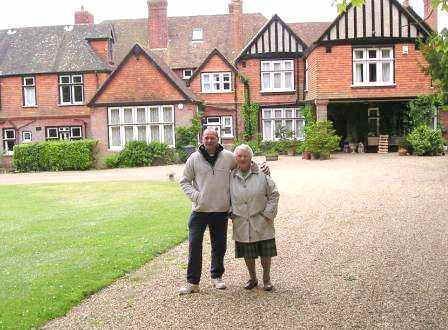
Margaret
and Nelson in Lime Park
Herstmonceux
Electricity Generating Works Circa. 1900 -
1936 Links:
Introduction
| Instructions
| ISBN
| Batteries
| Boiler
Room | Floor
Plan | Ron
Saunders
Industrial
Revolution
| Lime
Park | Machinery
| Map
| Power
House | Argus
1999
Public
Supply
| Roof
Construction | Rural
Supply | Sussex
Express 1913 |
Conclusion
Archaeology
South East
| East
Sussex CC | English
Heritage | SIAS
| Sx
Exp 1999
Memories
of Herstmonceux by Margaret Pollard
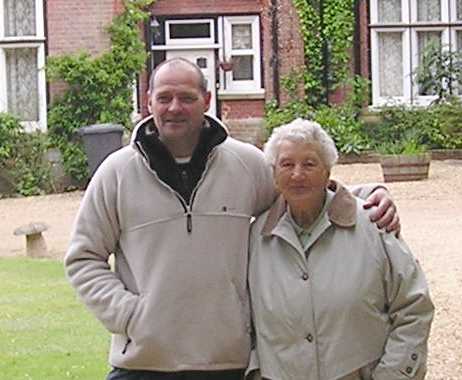
|